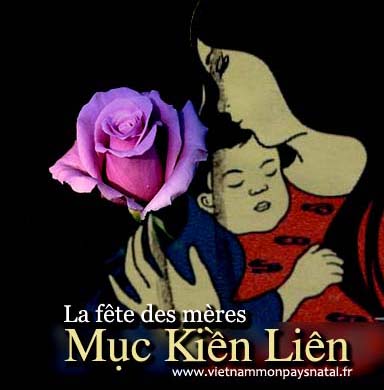
English version
Vietnamese version
Comme les Européens, les Vietnamiens ont aussi la fête des Mères. C’est la fête du Vu Lan au 15è jour du 7ème mois lunaire.
Il était une fois une dame méchante au nom de Thanh Ðề. Elle était impitoyable envers les pauvres et surtout envers les mendiants. Elle ne faisait jamais aumône et chassait tout mendiant qui se présentait au portail de sa maison. Elle n’hésitait pas à piétiner des grains de riz, recueillis par les pauvres paysans s’échinant à longueur d’année sur leurs terres. Elle se moquait des bonzes et des bonzesses en cherchant à rompre leur quiétude. Elle blasphémait Bouddha, méprisait les esprits et offrait à la pagode des victuailles de jeûne auxquelles elle avait mêlé des aliments carnés.
Malgré les conseils de son fils Mục Kiền Liên qui fut un bonze de haute vertu, elle ne l’écoutait guère. A sa mort, elle rejoignit le Royaume des Morts et dut payer ses fautes commises dans le monde des vivants: s’asseoir sur un lit à clous, porter sur la tête un seau rempli de sang, rester affamée et assoiffée car tout aliment qu’on lui mettait dans sa bouche se fondait en sang et se muait en flamme.
Lễ Vu Lan
Mục Kiền Liên, une fois l’illumination atteinte, put descendre dans le Royaume des Morts pour voir sa mère. Il fut témoin des châtiments qu’elle encourut. Il ne put rien pour changer le cours justicier du décret céleste et ne put pas non plus se substituer à sa mère. Il fut obligé d’aller voir Bouddha et demanda grâce à ce dernier. Celui-ci lui ordonna d’organiser au 15ème jour du 7ème mois lunaire, la cérémonie de Vu Lan, au cours de laquelle il pourrait solliciter la remise de peine pour sa mère avec les prières et l’aumône.
De retour sur terre, Mục Kiền Liên, le jour venu, dressa un autel en hommage à Bouddha tout en faisant aumône et cérémonie bien austère et fervente. Thanh Ðề, dans le Royaume des Morts, prit conscience de la souffrance comme elle fut sensible à la faim et à la soif. Les difficultés qu’elle rencontrait l’amenaient à se départir au fur et à mesure de sa nature méchante et à connaître le remords. La piété de Mục Kiền Liên remua la porte du Ciel. Le père céleste réexamina le cas de Thanh Ðề, constata qu’elle avait pu se repentir et l’acquitta. Il fut permis à Mục Kiền Liên de descendre dans l’enfer ramener sa mère à la vie.
Depuis lors, Thanh Ðề, de tout cœur, honora Bouddha, respecta les bonzes, secourut les pauvres. En s’inspirant de cet exemple, les enfants pieux, selon la coutume vietnamienne, au 15ème jour du 7ème mois lunaire, érigent un autel à la mémoire des défunts et font aumône aux pauvres.
Giống như người Châu Âu, người Việt chúng ta cũng kỷ niệm Ngày của Mẹ. Ngày này được gọi là lễ Vu Lan, rơi vào ngày 15 tháng 7 âm lịch.
Ngày xửa ngày xưa, có một người đàn bà độc ác tên là Thanh Đề. Bà ta đối xử tàn nhẫn với người nghèo, đặc biệt là với những người ăn xin. Bà ta không bao giờ bố thí và xua đuổi bất kỳ người ăn xin nào đến trước cửa nhà mình. Bà ta không ngần ngại giẫm đạp những hạt lúa mà những người nông dân nghèo quanh năm làm lụng vất vả trên mảnh đất của họ. Bà ta chế giễu các nhà sư, cố gắng phá vỡ sự yên bình của họ. Bà ta phỉ báng Đức Phật, khinh miệt các vị thần linh, và dâng lên chùa những món ăn chay trộn thịt.
Mặc dù con trai bà ta, Mục Kiền Liên, một nhà sư rất đức hạnh, bà ta chẳng thèm để ý đến lời khuyên của ông. Sau khi chết, bà đã gia nhập vương quốc Người chết và phải trả giá cho những tội lỗi mà bà đã phạm phải khi còn sống: ngồi trên một chiếc giường đinh, đội một xô máu trên đầu, luôn đói và khát vì bất kỳ thức ăn nào bà cho vào miệng đều tan thành máu và biến thành ngọn lửa.
Lễ Vu Lan
Sau khi giác ngộ, Mục Kiền Liên được xuống cõi Âm phủ để gặp mẹ. Ngài chứng kiến những hình phạt mà mẹ phải chịu đựng. Ngài không thể làm gì để thay đổi đường lối chính đáng của thiên mệnh, cũng không thể thay thế mẹ mình. Ngài buộc phải đến gặp Đức Phật và cầu xin lòng thương xót. Đức Phật chỉ thị cho ngài tổ chức lễ Vu Lan vào ngày 15 tháng 7 âm lịch, trong đó ngài có thể cầu xin sự tha thứ cho mẹ mình thông qua việc cầu nguyện và bố thí. Khi trở về trần gian, đúng ngày đã định, Mục Kiền Liên đã lập bàn thờ để tỏ lòng tôn kính Đức Phật, thực hiện việc bố thí và một buổi lễ trang nghiêm, sốt sắng.
Ở cõi Âm phủ, Thanh Đề nhận thức được nỗi đau khổ, cũng như bà nhạy cảm với đói khát. Những khó khăn mà bà phải đối mặt dần dần khiến bà từ bỏ bản chất độc ác và trải qua sự hối hận. Lòng hiếu thảo của Mục Kiền Liên đã lay động cánh cổng Thiên đường. Đức Cha Thiên Thượng xem xét trường hợp của Thanh Đề, nhận thấy bà đã ăn năn và tha bổng cho bà. Sau đó, Mục Kiền Liên được phép xuống Địa ngục để cứu mẹ mình sống lại.
Từ đó, Thanh Đề hết lòng kính Phật, tôn sư trọng đạo, giúp đỡ người nghèo. Lấy tấm gương này, những người con hiếu thảo, theo phong tục Việt Nam, lập bàn thờ tưởng nhớ người đã khuất và bố thí cho người nghèo vào ngày 15 tháng 7 âm lịch.










